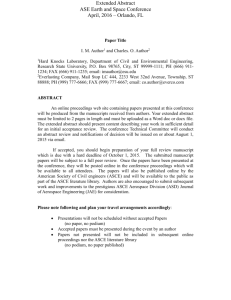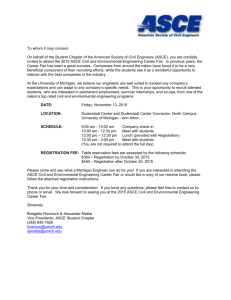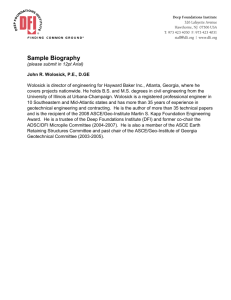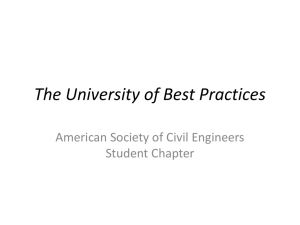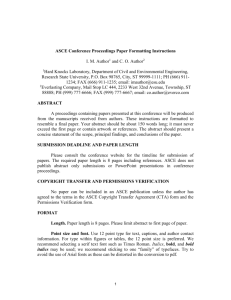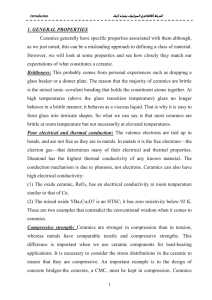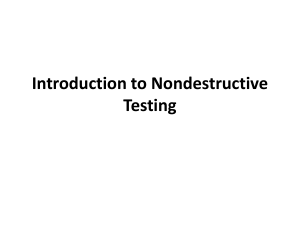Bridge Failures: Prevention, Inspection, Repairs
advertisement
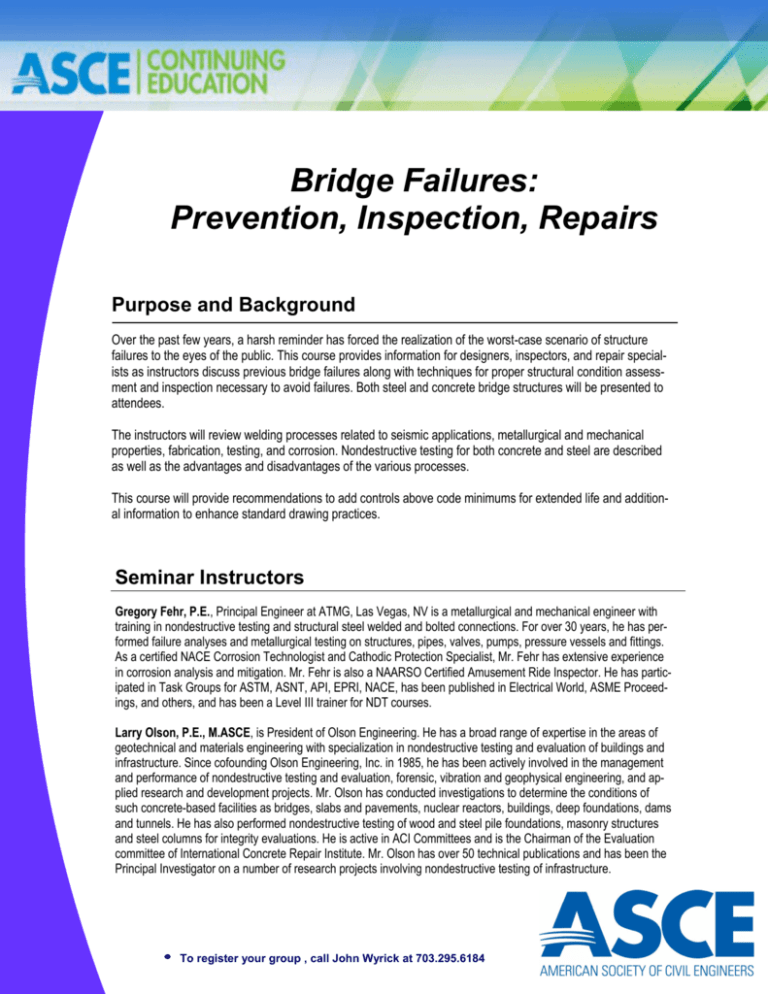
Bridge Failures: Prevention, Inspection, Repairs Purpose and Background Over the past few years, a harsh reminder has forced the realization of the worst-case scenario of structure failures to the eyes of the public. This course provides information for designers, inspectors, and repair specialists as instructors discuss previous bridge failures along with techniques for proper structural condition assessment and inspection necessary to avoid failures. Both steel and concrete bridge structures will be presented to attendees. The instructors will review welding processes related to seismic applications, metallurgical and mechanical properties, fabrication, testing, and corrosion. Nondestructive testing for both concrete and steel are described as well as the advantages and disadvantages of the various processes. This course will provide recommendations to add controls above code minimums for extended life and additional information to enhance standard drawing practices. Seminar Instructors Gregory Fehr, P.E., Principal Engineer at ATMG, Las Vegas, NV is a metallurgical and mechanical engineer with training in nondestructive testing and structural steel welded and bolted connections. For over 30 years, he has performed failure analyses and metallurgical testing on structures, pipes, valves, pumps, pressure vessels and fittings. As a certified NACE Corrosion Technologist and Cathodic Protection Specialist, Mr. Fehr has extensive experience in corrosion analysis and mitigation. Mr. Fehr is also a NAARSO Certified Amusement Ride Inspector. He has participated in Task Groups for ASTM, ASNT, API, EPRI, NACE, has been published in Electrical World, ASME Proceedings, and others, and has been a Level III trainer for NDT courses. Larry Olson, P.E., M.ASCE, is President of Olson Engineering. He has a broad range of expertise in the areas of geotechnical and materials engineering with specialization in nondestructive testing and evaluation of buildings and infrastructure. Since cofounding Olson Engineering, Inc. in 1985, he has been actively involved in the management and performance of nondestructive testing and evaluation, forensic, vibration and geophysical engineering, and applied research and development projects. Mr. Olson has conducted investigations to determine the conditions of such concrete-based facilities as bridges, slabs and pavements, nuclear reactors, buildings, deep foundations, dams and tunnels. He has also performed nondestructive testing of wood and steel pile foundations, masonry structures and steel columns for integrity evaluations. He is active in ACI Committees and is the Chairman of the Evaluation committee of International Concrete Repair Institute. Mr. Olson has over 50 technical publications and has been the Principal Investigator on a number of research projects involving nondestructive testing of infrastructure. To register your group , call John Wyrick at 703.295.6184 Bridge Failures: Prevention, Inspection, Repairs Seminar Benefits Attendees will gain from a relevant course that assesses, and covers problems and applicable solutions in order to prevent future bridge failures. Who Should Attend? Structural Designers Structural Engineers Structural Inspectors CEUs/PDHs: ASCE has been approved as an Authorized Provider by the International Association for Continuing Education and Training (IACET), 1760 Old Meadow Road, Suite 500, McLean, VA 22102. In addition, ASCE follows NCEES guidelines on continuing professional competency. Since continuing education requirements for P.E.. license renewal vary from state to state, ASCE strongly recommends that individuals regularly check with their state registration board(s) on their specific continuing education requirements that affect P.E. licensure and the ability to renew licensure. For details on your state’s requirements, please go to: http://www.ncees.org/ licensure/ licensing_boards/. Summary Outline Day 1 will cover Concrete and steel structural condition assessment and NDT Day 2 will cover Steel structural condition assessment, NDT, and welding/bolting Topics From Both Days Will Include: Examples of structural failures Structural condition assessment and inspection techniques Recommended conservative inspection applications Advantages and disadvantages of nondestructive testing techniques Low cycle low stress fatigue Mechanical and metallurgical properties of steels (hot formed through quenched and tempered). Fracture mechanics considerations Accelerated corrosion of weld joints Basic weld designs, seismic consideration Advantages and disadvantages of welding processes Special provisions and drawing details for welded structures Code minimums and improvements over code requirements How to improve ductility High strength bolting ASCE seminars are available for On-Site Training. For details regarding On-Site Training and/or needs-based training opportunities, please contact: John Wyrick, Senior Manager On-Site Training Worldwide ASCE Continuing Education Tel.: 703-295-6184 Email: jwyrick@asce.org

